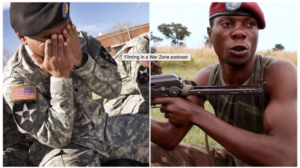How to Film in a War Zone
Documentary filmmakers have the opportunity to serve a witnessing function. Through their media they can present to a transnational audience both the visual conditions of war and a personalised narrative of the people involved in conflict [1]. In 2017, two such documentaries, This is Congo (Daniel McCabe) and Island Soldiers (Nathan Fitch) were released.

Figure 1: Stills of the soldiers depicted in Island Soldiers (left) and This is Congo (right) as lifted from the No Film School website.
In an interview with No Film School the two film directors share their advice on filming in conflict zones. The podcast makes for a valuable accompany piece to the two documentaries for any film activist preparing for a dangerous shoot. The directors give insight into the aspects of production; from choosing the appropriate film-making gear, sourcing grants and funding, their experiences of operating under gunfire and the process of embedding in military factions in the US and Africa. At a time when reporting in war zones is at its most dangerous, McCabe references the training resource RISC which serves as a non-cost first aid and protection program for conflict filmmakers [2].
Filming in conflict zones is dangerous but essential form of witnessing and this podcast provides testimony that may help prepare activists for shooting whilst risking being shot at.
Filmography
Island Soldier. USA. (Nathan Fitch, 2017)
This Is Congo. Italy. USA. (Daniel McCabe, 2017)
References:
Leshu, T. (2012) Creating the witness: documenting genocide on film, video and the internet. pp. 21-60.
McCabe, D., McClean, G. 2013. This is Congo. Kickstarter. Accessed November 27 2018. https://www.kickstarter.com/projects/thisiscongo/this-is-congo?ref=nav_search&result=project&term=this%20is%20congo%20
Nord, L. (2017). How to film in a warzone. No Film School. Accessed November 27 2018. https://nofilmschool.com/2017/12/how-film-war-zone
RISC. Accessed November 28 2018. https://risctraining.org
Woodyear, L. (2003). In today’s world, journalists face greater dangers. World of Work Magazine. (47).
